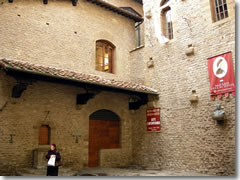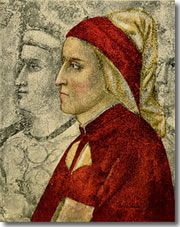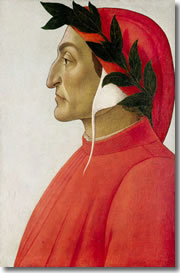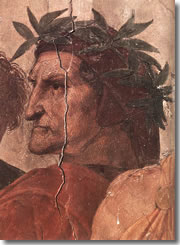
Exterior of the Casa di Dante. (Photo by Sailko) First things first: this was not Dante's house.
No, it never was.
The small museum of reproduction memorabilia that fills a few rooms of this lovely 14th century townhouse is dedicated to the great medieval Florentine poet, but he never actually lived here (though there is evidence his brother might have owned it).
Dante probably lived next-door to "Dante's House," or maybe just down the block. Where, exactly, we do not know. We just know it wasn't here.
I guess calling it "The Museum of Dante's Neighbor's House" didn't quite have the same ring to it.



How great was Dante? Every important artist wanted to paint him, from his contemporary Giotto (top) to Botticelli (middle) to Raphael (bottom) and many more—Dante always in his trademark floppy red hat, and usually wearing a laurel corona signifying his status as Italy's eternal poet laurate.Dante Alighieri (1265–1321) was a minor politician and closet scribbler whose political career fizzled and died but whose poetry went on to become among the most famous works of all time and, because of its fame, pretty much codified Dante's early 14th century Tuscan dialect as the basis for modern Italian.
How important is he in Italy? They put his portrait (taken from a fresco by Raphael, pictured to the right on the bottom) on the largest coin they could: the Italian €2 piece.
Few, outside of Italian high school students, ever read Dante's La Vita Nuova ("New Life") poetry collection, and only scholars bother with his lesser works, but just about everyone has heard of Dante's Inferno.
Inferno is actually just the first of three books in Dante's Divine Comedy magnum opus, a medieval masterpiece of an epic poem in which Dante takes a highly metaphorical tour through the afterlife during Easter Week of the year 1300.
(The two subsequent books were Purgatorio and Paradiso, but—just like in a good Renaissance fresco of the Last Judgment—it is Hell, the Inferno, full of demons and sinners and their torments, that is by far the most interesting).
The Dante alter ego in the story is guided through the first two realms of afterlife by the shade of the Roman poet Virgil.
But in Paradise—which, as a pagan, Virgil cannot enter—Dante is accompanied instead by the ghost of his beloved Beatrice (pronounced bay-ah-TREE-chay in Italian).
Beatrice was not Dante's actual wife (Dante married a woman named Gemma Donati), but rather the beautiful girl next door who was Dante's first love-from-afar, whom he met precisely twice in his life (once when Dante was nine and she eight, again when he was 18), and who died at the age of 24.
This wasn't as creepy or as heartless as it sounds to modern ears.
Think of the knights of old, who had earthly lovers and/or wives but also had "courtly loves" and fought in the name of their queen or carried favors of their lord's lady into battle. (This is why Lancelot's affair with Arthur's Guinevere was so scandalous; you were supposed to love your queen from afar, not in your actual bed.)
Well, medieval artists often had both a practical, everyday wife at home but then found their muse in a more pure, chaste, quasi-Heavenly love for another woman, often one of higher station, in whose name they privately fought their own battles with inspiration.
Here's a fact most Florentine tourism officials don't like to talk about: Dante wrote the works for which he is most famous after he left Florence for good.
The Divine Comedy was written while Dante was living out the final 21 years of his life in exile.
The Black/White Guelf infighting was an offshoot of the Europe-wide Guelf-Ghibelline battles of the 13th and 14th centuries. (This next part gets a bit professorial and may bring up unwelcome memories of 10th grade history class, but stick with it and you'll witness the birth of the modern world.)
In brief: The Pope was vying with the Holy Roman Emperor for temporal power in Northern Italy and other bits of Europe. If you backed the pope, you were a Guelf. Backers of the emperor were called Ghibellines. Those weird names were inherited from a conflict a century earlier between two warring ruling families in Bavaria and Swabia. It gets complicated.
Practical upshot, most of the landed nobility where Ghibellines, supporting the emperor to maintain the Dark Ages status quo and its complex power structure of feudal lords and vassals that kept them in charge.
Most of the city burghers and emerging merchant class were Guelfs, supporting the pope, who would break the feudal power matrix and allow this new way of life to flourish outside the rigid old class system.
The Guelfs eventually won, which helped spell an end to the Dark Ages, heralded the ascendancy of the middle class, assisted in the rise of Humanist philosophy and an increasing interest in education—Pope didn't see that one coming—which in turn allowed for the flowering of the Renaissance, and essentially marked the start of the modern world.
Not for the Guelfs, of course. They almost immediately splintered into two factions—Black and White, supposedly after the felicitously opposing surnames of two Pistoia families, whose feud sparked it all—and started fighting amongst themselves.
Poor Dante got the short end of the stick. (Yay, we got back to Dante!) But had he not been a political failure, he might never have turned his attention to his writing, and we would all be the poorer for it.
So why was the greatest writer in Italian history—one of the great world poets of all time—exiled? He had the bad luck of throwing in with the wrong political party, the White Guelfs (see the sidebar on medieval Florentine politics—more complicated, and fascinating, than it sounds).
When the Black Guelfs, backed by France, marched into Florence in 1301 and seized power, Dante was in Rome as part of a White Guelf embassy to the pope to try to convince him to back the Whites.
With the Black Guelfs in charge of Florence, Dante was subsequently convicted in absentia on trumped up charges—as was just about every other White Guelf. He was ordered to stay out of Florence for two years and to pay a hefty fine.
Since Dante felt he had done nothing wrong, he refused to pay and, as a result, never returned to his beloved hometown.
He roamed Italy, staying with sympathetic friends, from Rome to Lucca to Verona, and finally to Ravenna.
Dante died, in Ravenna, in 1321 and his body remains there to this day.
Trust me; that's the short version of the great poet's life—and an extreme glossing over of the major political conflagration of his age (see the sidebar on the right).
Notwithstanding the lie inherent in its very existence, "Dante's House" does remain a fine example of a private upper-class home from Dante's era—and one of the few remaining buildings, albeit a bit altered over the centuries, in this neighborhood at the heart of central Florence.
If you're seriously into Dante, give it a whirl—though if you don't speak Italian, much will be lost on you as very few of the modest displays about Dante's life and his greatest works are multi-lingual.
If you happen to be passing by, there is a spiffy little gift shop full of Dantiana—lavish editions of his works, the entire Divine Comedy printed in microscopic type on a poster, that sort of thing—that you can enter without paying the admission fee to the modest museum itself.
Most Italians content themselves merely with snapping photos of one other standing in front of the place.
"Dante's House," if nothing else, bang in the geographic center of Florence, tucked into the labyrinth of medieval alleys that tangle between the Duomo and Piazza della Signora.
So if, midway through the your walk across Florence you find yourself in this dark alley where the straightforward path has been lost, you can pop inside to buy a translated edition of Dante's Inferno and see just how much of a geek I just proved myself to be with this sentence.
Via Santa Margherita 1 (3 blocks west of Via del Proconsolo; one block south of Via del Corso)
tel. +39-055-219-416
www.museocasadidante.it
Apr-Sep: Daily 10am–6pm
Oct-Mar: Tues-Sun 10am–5pm
€4
With Firenze Card: Free
Bus: C2; 14, 23, C1
Hop-on/hop-off: Teatro Verdi (A)
Planning your day: Even Dante fans won't spend more than 30 minutes. Those with a passing interest (or in need of a present for a literary-minded friend) might pop into the gift shop for five minutes.
Take a guided tour of Museo Casa di Dante with one of our partners:
Share this page
Search ReidsItaly.com
Via Santa Margherita 1 (3 blocks west of Via del Proconsolo; one block south of Via del Corso)
tel. +39-055-219-416
www.museocasadidante.it
Apr-Sep: Daily 10am–6pm
Oct-Mar: Tues-Sun 10am–5pm
€4
With Firenze Card: Free
Bus: C2; 14, 23, C1
Hop-on/hop-off: Teatro Verdi (A)